Varanasi.
Part Two. The Fall
“And now listen,” says the guide, “I work here as a volunteer. I collect money to help such poor dying people. Funerals cost a lot, it takes 40 kilograms of firewood. One kilogram costs 500 rupees. Not everyone has that kind of money, so we collect donations. Usually, tourists give for 10-20 kilograms. But of course, it’s up to you. It’s your karma after all.”
If the reader hasn’t figured it out yet, this whole excursion is one big planned show where the tourist is first stuffed with stories about karma and taken to a cemetery among burning corpses (real ones), and then led to a creepy house with a dying beggar woman (possibly in disguise) and fed a tale about volunteering and expensive firewood. Try refusing to give money after seeing and hearing all that. Such a walk through the crematorium, among burning bodies, seasoned with discussions about the meaning of life and karma, sends shivers down your spine and shuts off your reasoning. Try refusing! You’ll ruin your karma for life because you’re not somewhere else, but in the center of the Hindu world, the sacred and oldest city of Varanasi!
Oh, if only I could remember how much those firewood actually cost: twenty, thirty rupees? Definitely not five hundred! If only I could recall the exact amount, I would surely tell him what I really think. But I couldn’t remember the prices, only that the firewood was much cheaper.
“Understood,” I muttered, “okay, I’ll give you 200 rupees, deal?”
“... What?! Two hundred rupees? Are you kidding? Everyone donates at least three thousand!”
“I don’t have three thousand. I’ll give you two hundred rupees.”
“But I can’t even buy a kilogram of firewood with that!”
“Well, buy half a kilogram then,” a brilliant suggestion.
“They don’t sell them in half-kilograms!” a brilliant response.
“Fine. I’ll give you three hundred rupees, and that’s it.”
“So be it... Well, friend, as you wish. It’s your karma, your decision. Go, give it to her yourself, look her in the face.”
I approach the old woman and hand her three hundred rupees. She extends her trembling hands, takes the money, and looks at it. At that moment, her face takes on features of such overwhelming astonishment that it seems she will forget about impending death, jump up, and I’ll have to run away from her. Apparently, people do usually give several thousand rupees.
After giving the money to the old woman, I quickly start making my way back to the boat. The guide catches up with cries:
“Hey, wait, what about my money?!”
“Oh, you also want money? Take half from her.”
“I can’t take it from her, it’s for her funeral. Pay me personally for the tour!”
Realizing that he won’t let me go so easily, I throw him forty rupees and sit in the boat.
But a second before we set sail from the shore, my guide from yesterday magically appears out of nowhere. I shamelessly ditched him earlier this morning when I left an hour before our scheduled meeting. Bad luck. I pretend not to recognize him. He doesn’t give up. The boatman starts realizing something is not right, and he turns the boat back towards the shore, where my enraged assistant awaits me. I decide to take the offensive first:
“Oh, it’s you! Didn’t recognize you at first. Listen, where were you? I waited for you for half an hour and then left.”
“What? I was waiting for you for half an hour!”
“You must be joking? We agreed to meet at half seven. I went out — you weren’t there.”
“I also came at seven thirty, waited for you for half an hour, asked the hotel owner, and he said you went out at six thirty.”
“Oh, buddy. Where did you learn English? You said you’d come at half seven. That means six thirty. You should brush up on your language skills.”
“Oh yes, indeed. I got confused with the timings, my apologies.”
“Well, there’s nothing we can do now. I’ve already explored the city myself. Alright, let’s go, I’ll give you the money for yesterday’s assistance. I don’t have it with me, we need to go to the hotel.”
The trick was that the phrase “half seven” is used quite rarely, even in British English. Usually, people say “half past seven.” Without the key word “past,” it’s not entirely clear what is meant: half of the seventh hour or half an hour after seven? The phrase can easily mislead even a native speaker, including an American. Not to mention an Indian.
Having reached the pier, we disembarked and headed towards the hotel. Today the guy was taciturn, walking almost silently. He only asked if I had managed to see the whole city and if I wanted to buy cannabis from him. Yes, definitely. I handed him two hundred rupees, keeping another hundred hidden in my pocket.
“Here, take it. Will two hundred rupees be enough?”
“Not enough. Can you add more?”
“I can. Let’s just take a little walk.”
“Uh-uh-uh, where to? There? No, not there, let’s go in the other direction”, my pursuer from yesterday became agitated.
“It doesn’t matter to me. Listen, tell me what’s going on here? Why did a fake volunteer at the crematorium trick me into giving money, talking about karma? Do you people believe in karma yourselves?”
“How much did you give him?”
“I gave him three hundred rupees.”
“You found something to worry about. Sometimes they scam for ten thousand.”
“And is it normal, according to you, to do this right at the cemetery?” — I tried to impart some moral lesson.
“Everyone does what they can. So, will you give another hundred?”
About an hour after everything that happened, I was resting in my room. Varanasi was driving me crazy. I urgently needed to talk to someone sane in this place. And such a person was found, but first, we had to go around the whole city.
⁂
Indeed, Varanasi is beautiful only in one place — on the waterfront. The rest of the city presents a depressing sight. And if the streets near the Ganges still have some minimal appeal...

Outside the city center, everything is really bad.

There is a lot of garbage everywhere. And cows rummage through it.

Monkeys also eat something.
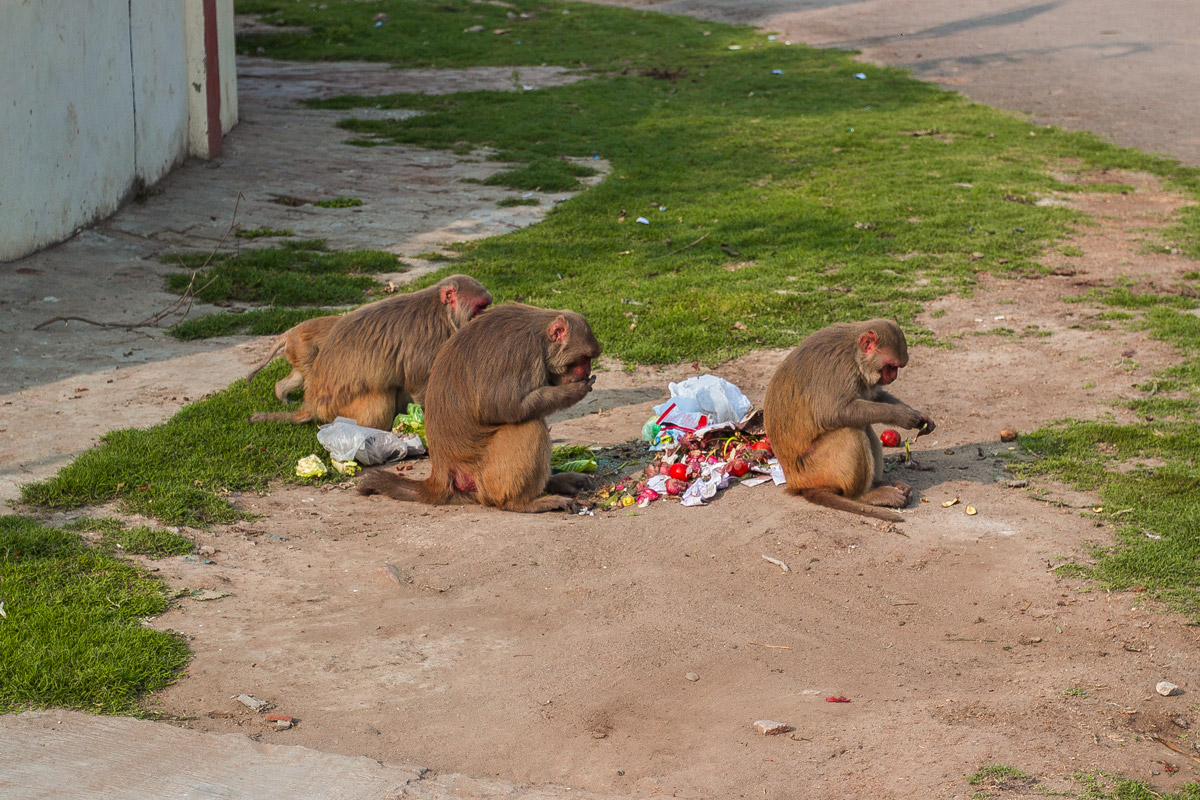
And sometimes people even make a fire out of garbage right in the middle of the street.

There is a lot of makeshift construction, as in any Indian slum. There is no proper sewage or water supply in these huts; water is drained into gutters along the streets. Although the presence of storm drains and roads at an angle is already a great achievement, not every Russian city has them. Perhaps this system was inherited by Indians from the British.

Suddenly, a cow.

Cows roam the streets of Varanasi with ease and freedom. They walk around and defecate wherever they please. No one properly cleans up the feces: when a sacred animal leaves its droppings, all the streets get littered with piles of dung. It’s impossible to avoid stepping into it.
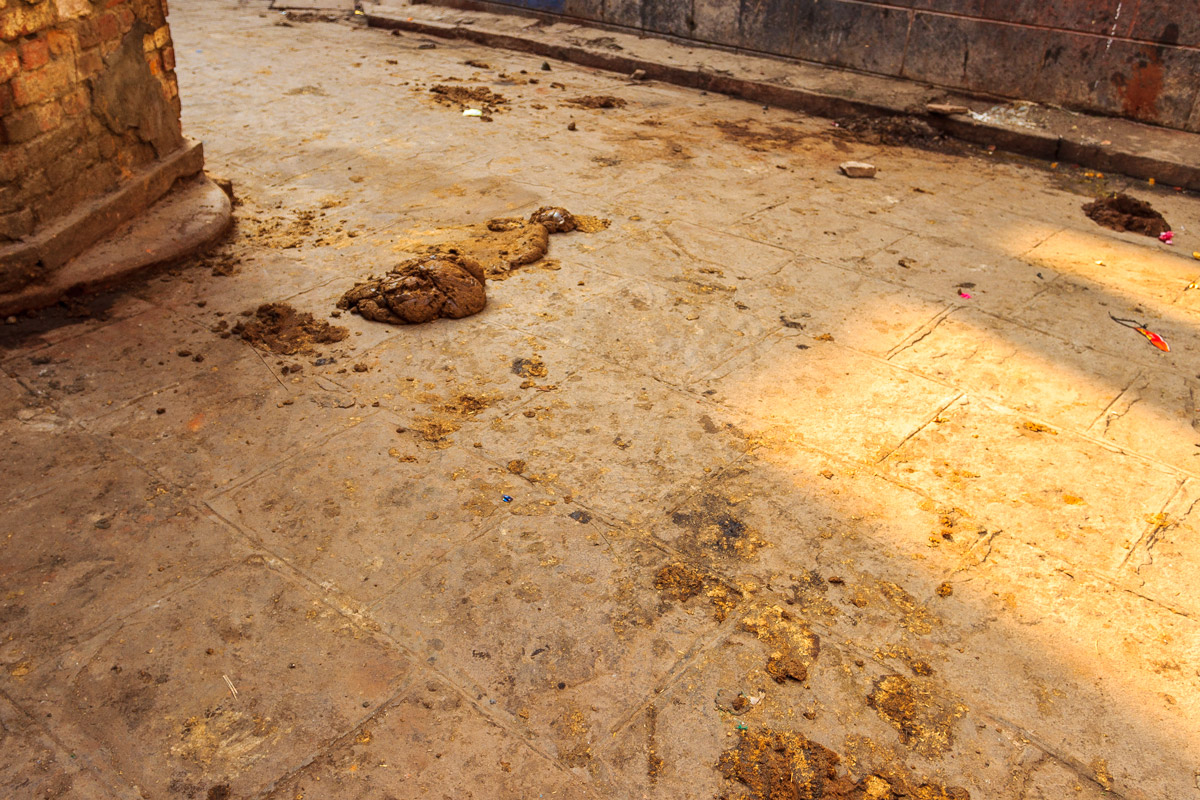
The wider streets resemble Delhi. There are lots of rickshaws and a market.

The devastation is truly dreadful. It resembles more of Africa.

Not far from the city center. There are hardly any roads, all broken and covered in sand. The red sculpture in the center hints that it is a square.

Poverty. Makeshift shelters.

How can one live here? And on top of that, each family has three to five children.

Someone, of course, amidst this poverty, builds three-story mansions with penthouses for themselves. The gates of this house alone cost more than what the majority of the population earns in a month.


School buses.


School bicycle. It gets packed with children to the brim, and the poor driver pedals them to school.

Hospital.

Advertisement for automotive oils.

Ashram.

Somebody sleeping on the rooftops.

Working.

Peeing. Indians are completely unabashed in this regard.

Stand-pipe.


Scales. Such scales can often be found near the ghats. They are usually used to weigh firewood.

Gas ballons. Such ballons can be found everywhere in India. They are used for cooking on stoves, as not all homes have access to gas.

According to official statistics, only 29% of the city’s residents are employed. 77% have the ability to read and write.

This is what Varanasi looks like outside of the city center. It’s worth returning to the waterfront — it’s like Italy!

Next to my hotel, there was an inconspicuous tent where various small items were sold: cigarettes, lighters, chips, water. Behind the counter sat a young man wearing glasses. One day, as I walked by, I noticed a notebook with some calculations on his table.
“Hi, buddy! What are you studying?”
“This is physics. Optical systems.”
“Cool, can I take a look?” I took the notebook and flipped through it. It was filled with quite complex calculations that were not even taught to us at the Aviation Institute. “Are you studying at a university?”
“Yes, at Banaras University.”
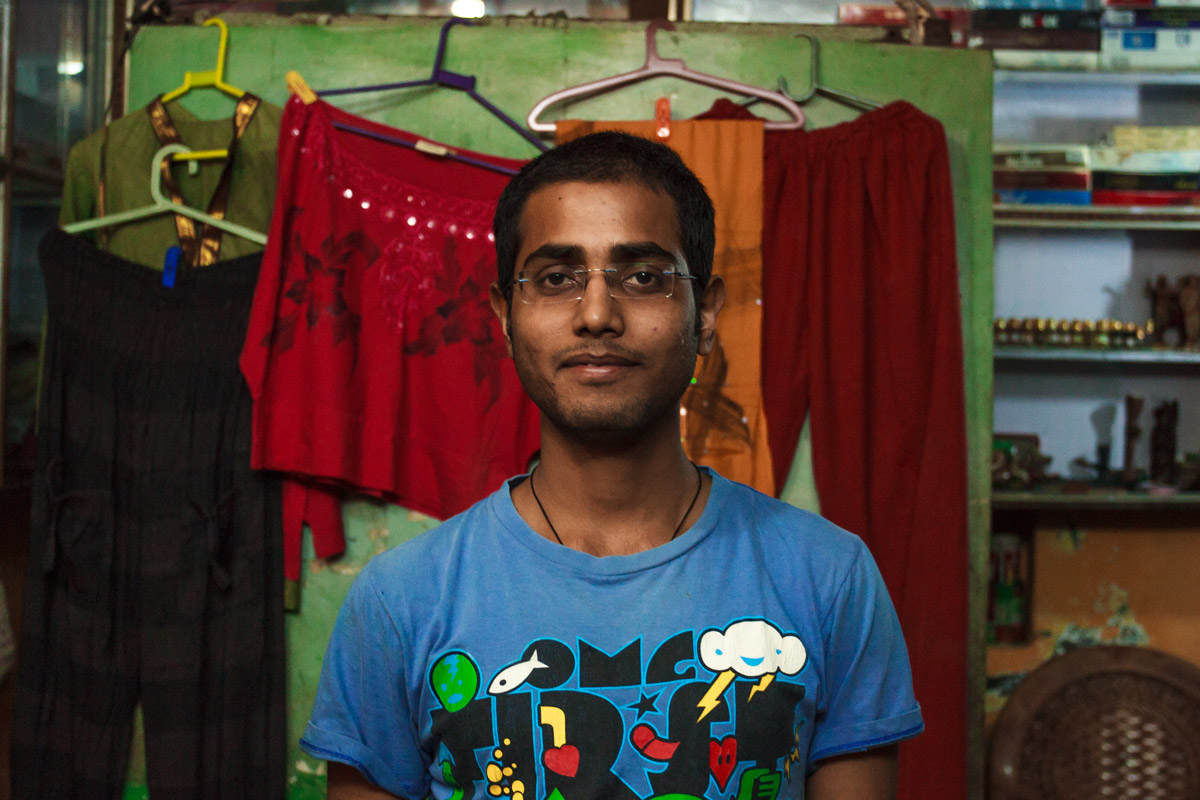
Vikash Seth is a student at the Department of Physics, Banaras University, one of the largest universities in India. Surprisingly, in Varanasi, there is an institute that is even called the “Eastern Oxford” because talented scientists who have received education in England teach there.
Vikash is studying, doing homework, and simultaneously managing the family business by looking after the trading stall. He dreams of becoming a scientist. This young talent has no plans to leave the country; his goal is to improve life in India and provide for his family. After a brief interview with Vikash on various abstract topics, I can’t resist and start asking about what is happening in Varanasi.
“Do you have internet here? I would like to show something.”
“Yes, here’s a computer — go ahead and show me.”
I open Google and find images of corpses being eaten by dogs. These photos are taken here, in Varanasi. Many people come here to see these shocking pictures. Perhaps the reader also has encountered such images in other stories about India. But how is this possible? Is this city really so monstrous that even dead bodies lie in the middle of the streets? I ask Vikash this question.
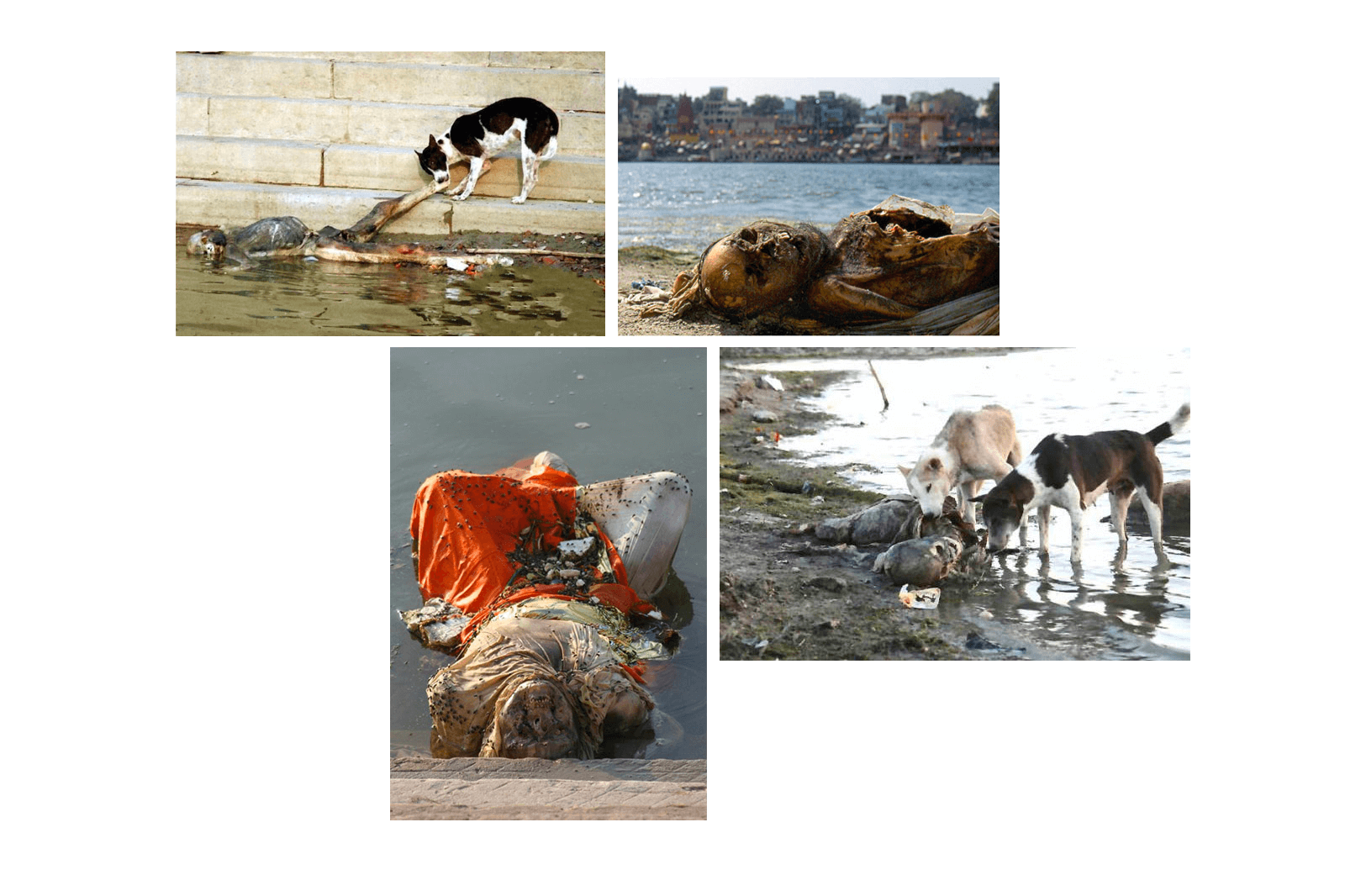
“What is this? I found these photos in a report about Varanasi, but I walked along the entire waterfront and didn’t find anything like this.”
“Hmm... well...” Vikash frowned. “This sometimes happens. Here’s the deal: normally, corpses are cremated, leaving only ashes that are then immersed in the Ganges. But sometimes cremation is not possible. Extremely obese people or pregnant women cannot be cremated because it would be a horrifying sight as everything would spill out and... So they simply tie them to a heavy stone with a rope and throw them into the river. Sometimes the ropes rot, and the partially decaying bodies float up and get washed ashore. These photos are about those cases.”
“I’m speechless. Does this happen often?”
“Not exactly frequently. Every couple of months, someone can resurface. They are quickly removed, so the author of these pictures is either lucky or just hunted for such shots.”
“I see. So, I was looking for nothing along the entire waterfront... Another incident happened to me: a person who introduced themselves as a volunteer took me around Manikarnika, talking about karma and funerals. Then they took me to a hospice where an elderly woman was dying and literally started extracting money from me under the guise of prayers. It’s incredibly hypocritical!”
“You’re right, of course. But here, everyone earns however they can. They’re not concerned about karma. They belong to the lower caste, workers at the mortuary. Their main focus is getting money, no matter how. They’re not volunteers. Perhaps a tiny portion of the money actually goes towards funerals, but most of it goes directly into their hands, and the boss as well. Funerals in Varanasi is a business.”
Then I showed Vikash a photo of a white sadhu that I took last night. Sadhus are Indian hermits, enlightened yogis who have renounced worldly life. When I tried to capture one of them on the waterfront, he unexpectedly covered his face with his hands.
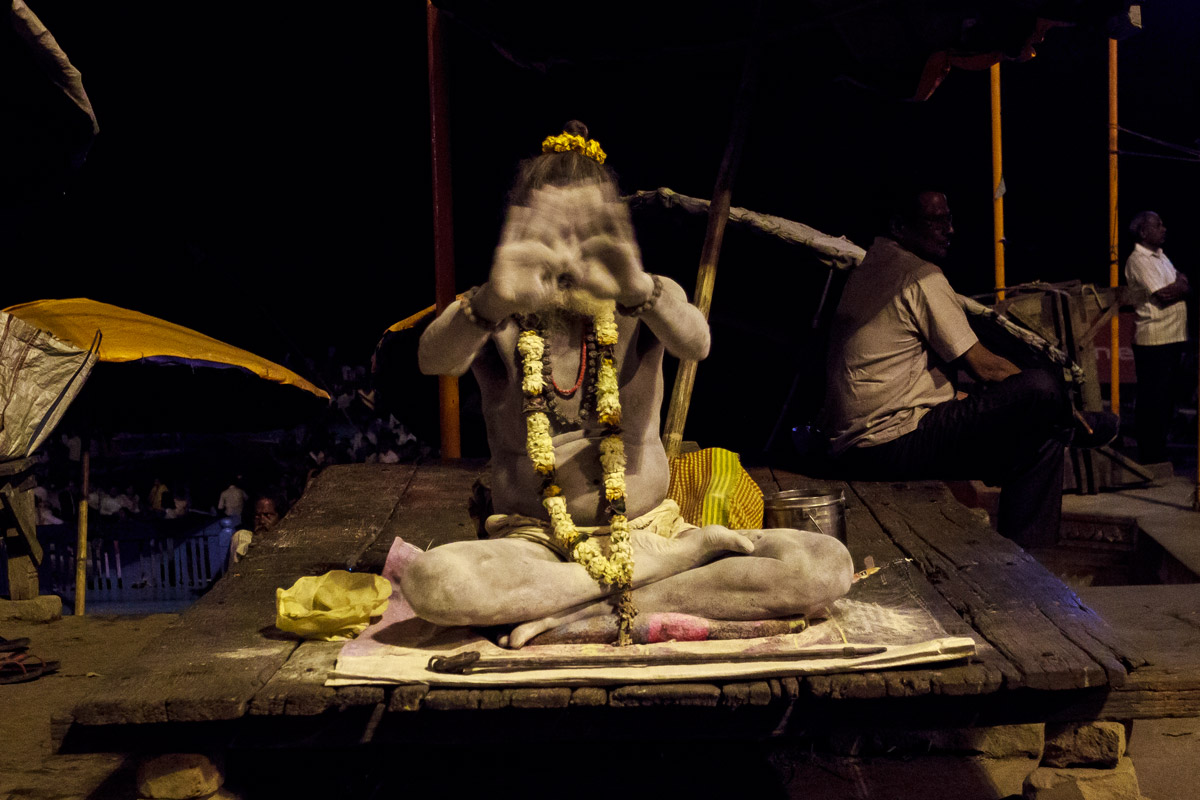
“What about those people in strange attire sitting on the waterfront?”
“Those are sadhus.”
“I thought something was off with them. When I tried to photograph an old white bearded man, he covered his face with his hands and strictly forbade me from taking his picture. Then he beckoned me with his hand to pay him money. I thought donations were voluntary. Is it just a show for tourists?”
“Well, yes, in a way. It’s exactly that, just a show.”
“So these sadhus are not genuine, then?”
“Yes, they’re not genuine. Or rather, they might be genuine in some sense. But genuine sadhus don’t behave like that. Sadhus are very intelligent and wise individuals. A true sadhu would never spend their entire day collecting money for photographs. Real sadhus live in their ashrams and don’t take money from anyone: if you want, you can visit them, talk to them, take photos. If you give them something, they will accept it. But they won’t ask for anything themselves.”
“How disappointing... This is not what I expected to find here...”
“Yes, but we can’t blame them. Everyone earns however they can. Some engage in trade, like my family, while others know how to dress extravagantly and attract attention. People pay for photographs, they enjoy it. Why not?”
Sadhu is a calling card of Varanasi. On the internet, you can find many colorful photographs of absolutely fascinating elders dressed in peculiar garments, with braided hair and long beards. It seems like they are the very gurus who know the answers to all questions.
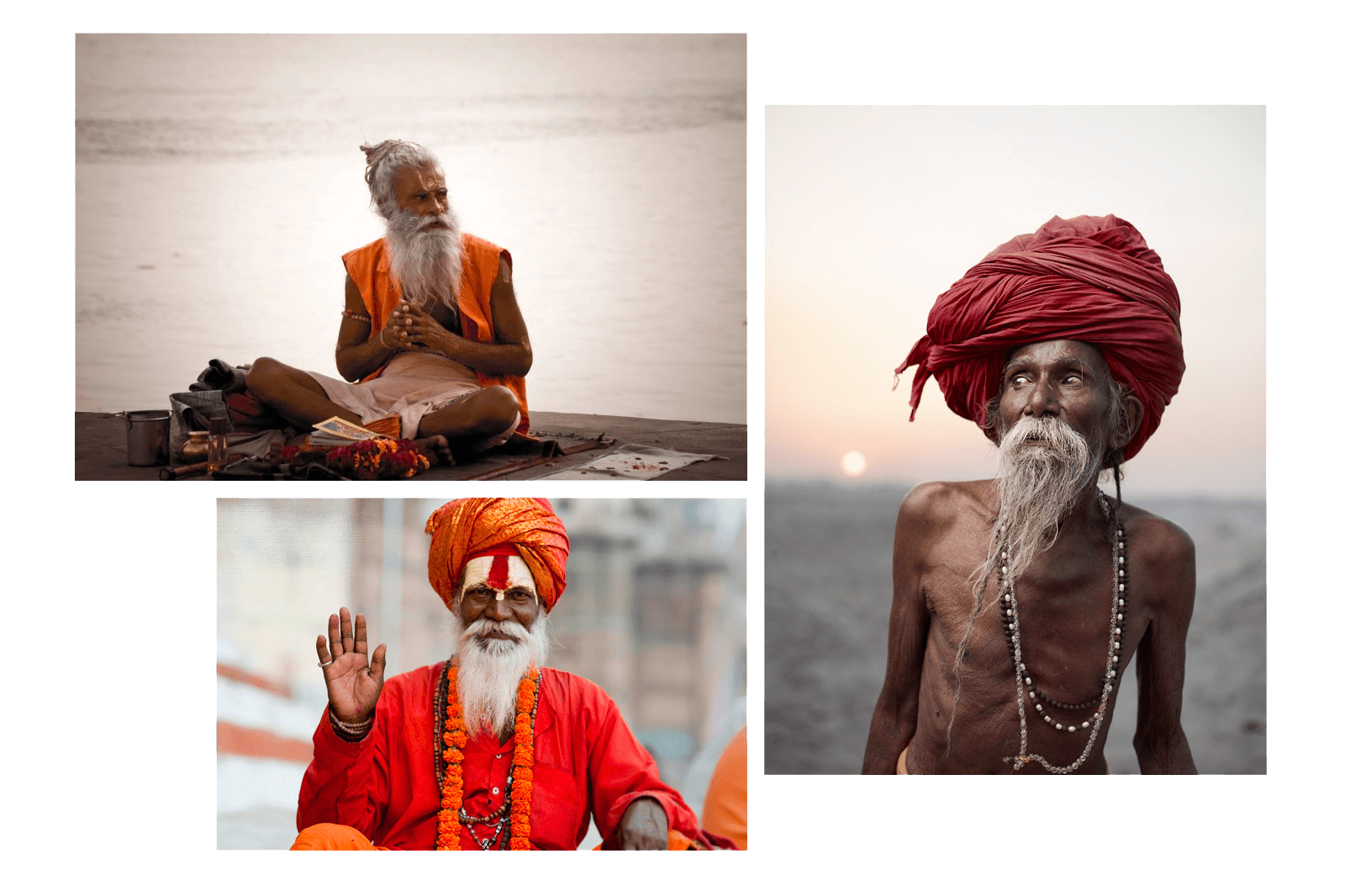
In reality, everything is much more prosaic. These sadhus are ordinary disguised wanderers who sit in one place all day and beg for alms. They charge several hundred rupees for a single photograph. Naturally, such a situation did not suit me, so I came to the festival in the evening, sat about fifteen meters away on the stairs, calmly set up my tripod, and started capturing the elders through a telephoto lens. There he is, a handsome one. The white sadhu.

And here’s how he takes the money.
The main income comes from the festival. Every evening, the Varanasi waterfront turns into a colorful show. Large crowds gather, mostly consisting of tourists from other cities in India.

For money, you can rent a boat and watch the performance from the water.

While onlookers are watching the spectacle, pickpockets and scammers operate in the crowd.
While I was squatting down and filming, a six-year-old boy in traditional clothing approached me and tapped my shoulder with his hand. When I turned around, I saw a thin child’s hand reaching towards my forehead, the index finger of which was smeared with red paint. “Here it is, the contact of civilizations,” flashed through my mind. And so, leaning my forehead towards his hand, I received the coveted red dot. An amazing feeling. But the ecstasy didn’t last long: immediately, the boy showed a painted plate with flowers on it, neatly arranged with a hundred rupees.
Here’s the situation: I got the dot, but no one warned me that the paint stroke costs a hundred rupees. And the boy was so young and cute. I offered to exchange my last hundred rupees for fifty rupees. Just as if on cue, a second boy ran up.
“He doesn’t have change, let me give you change!”
“Well, go ahead.”
“But first, I’ll put a dot on you, otherwise it’s a bad omen.”
“Fine, go ahead.”
After putting the dot, he started counting out the change. He counted it out, gave me the money, and pointing to his friend, said:
“Now pay him as you planned,” and I paid.
“Now pay me. You got two dots.”
“Oh, really? Take half from your friend then!”
Nowhere in India do they scam as brazenly as in Varanasi. They construct subtle psychological scenarios and are as persistent as mosquitoes. You can refuse, but sooner or later, your strength runs out. It reminds me of a joke about Chinese hackers trying to break into the Pentagon using the password “Mao Zedong.”
However, apart from these scoundrels, the festival leaves an incredible impression. It is very beautiful and unusual.
After the end of the performance, the city waterfront quickly empties. It is bathed in yellow light, and the walls of the old fort look even more mystical.



Nighttime Varanasi.


Everyone disperses to their homes.

I was returning to my hotel, which was located not far from the Manikarnika Ghat. I was walking with a tripod and a camera slung over my shoulder. Naturally, as I approached the ghat, locals surrounded me and began saying that filming was not allowed there. I denied that I was going to film anything and explained that I was simply heading to my hotel. However, one Indian man persisted and kept mentioning something about “mi-shun.” Finally, I understood that he was referring to “permission.” I stood frozen in place.
“So you’re saying that you can allow me to photograph the crematorium?”
“Yes, yes, I can ask my boss! You can capture whatever you want!”
“How much does it cost?”
“Two thousand rupees.”
“Ha. Your boss personally offered me a thousand this morning.”
“Alright, alright, let’s do it for one and a half. Come tomorrow morning at half past six. I’ll be waiting for you at this spot.”
By the way, there is no official ban on filming. According to the law, you can film absolutely everything. However, unfortunately, the crematorium is controlled by a local gang. No wonder: millions of people want to die in Varanasi! And they are willing to pay money for it. That’s why it’s impossible to film here in practice. The bandits will instantly surround anyone who takes a picture. In the best case, you will have to delete the photograph; in the worst case, you will be chased away with sticks and stones.
In theory, it is possible to obtain permission from the city hall, but it is very difficult. And it won’t help at all: everyone doesn’t care about that piece of paper unless you come with the local police. But who wants to start such a war? It’s useless to storm the impregnable bastion of Manikarnika by force. A hidden camera won’t help either: they will either notice it or the pictures will be of terrible quality. No, none of this works. In this system, there is only one loophole: their own greed.
I arrived in the morning at the appointed time, and I was led to the bonfires.
“Here you go, feel free to film whatever you want.”
“What can I capture from here? I need a close-up.”
“Alright, come with me.” They led me around the stone fence, guided me through an opening in it, and let me onto the actual platform where the bonfires were burning.
“No, that’s not good either. I can’t see the body from here.”
“Fine, come here.” The stoker brought me very close to the bonfire. Charred legs wrapped in cloth protruded from it.
“No. Those are legs. I want to shoot the head.”
I wish they would throw me into the cauldron for such words. But the stoker didn’t even bat an eye. He led me around the bonfire and brought me to it from the front. I don’t know why he didn’t do it right away, step by step extracting my requests from me. I’m sure that if I had asked him to turn the body over for a more successful shot, he wouldn’t have refused and would have poked the fire with a poker. But which one of us has lower karma now after such words?
The heat, whether from the fire or from my own thoughts, struck my face. A head protruded from the fire, surrounded by flames.

I took exactly one shot to avoid giving them a reason to demand payment for each picture.
“Is that all? Just one shot? Come on, take some more, why not?”
“No, I only need one shot. That’s enough.”
“Well, up to you. Let’s go, step aside.”
The stoker led me aside, and I paid him the promised one thousand five hundred rupees. As expected, I heard the following from him:
“Thank you. This will go to charity. Can you also pay me?”
“Pay you? Take some from these, no one will know.”
“No, I can’t do that. It’s bad for karma.”
“Bad for karma... Listen, how much does a kilogram of firewood cost?”
“Why such questions? Around five hundred rupees, somewhere around that.”
“No way! I checked the prices, a kilogram costs five rupees. You have a business going on here, I understand it all.”
“Hmm, well, no, those are cheap firewood priced at five rupees. We use mangrove...”
“What?! Alright, forget it. I won’t give you anything for now.”
Those were my last moments in Varanasi. Right after that, I packed my things and headed to the airport. Only the melody of a children’s song, accidentally heard from a nearby ashram along the way, lingered in my mind for a long time.


